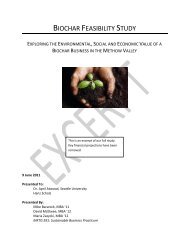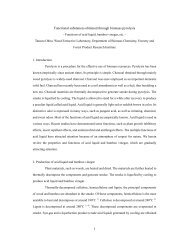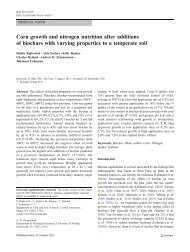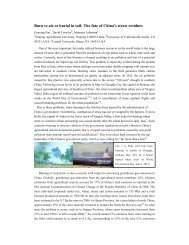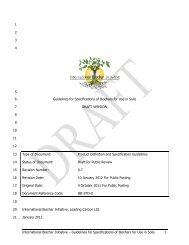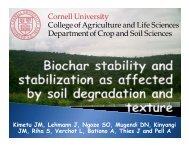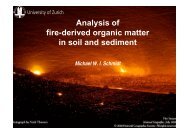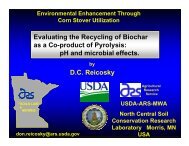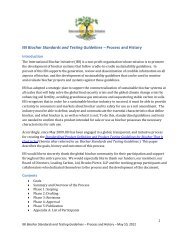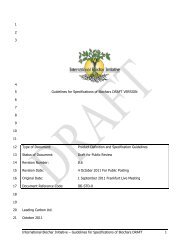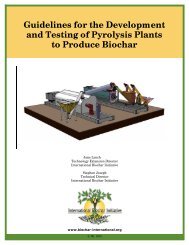yields in Western Australia were improved by banding biochar (Blackwell et al., 2007).When working by hand, biochar can be applied in furrows opened using a hoe and closedafter applying biochar.4.1.3 Mixing biochar with other solid amendmentsMixing biochar with other soil amendments such as manure, compost or lime before soilapplicati<strong>on</strong> can improve efficiency by reducing the number <strong>of</strong> field operati<strong>on</strong>s required.Since biochar has been shown <strong>to</strong> sorb nutrients and protect them against leaching (Major,2009; Major et al., 2009; Novak et al., 2009a), mixing with biochar may improve theefficiency <strong>of</strong> manure or other amendment applicati<strong>on</strong>.4.1.4 Mixing biochar with liquid manures<strong>Biochar</strong> can also be mixed with liquid manures and applied as a slurry. Fine biochars willlikely be best suited <strong>to</strong> this type <strong>of</strong> applicati<strong>on</strong> using existing applicati<strong>on</strong> equipment, anddust problems associated with these would be addressed. <strong>Biochar</strong> could also be mixed withmanure in holding p<strong>on</strong>ds and could potentially reduce gaseous nitrogen losses as it doeswhen applied <strong>to</strong> soil (R<strong>on</strong>d<strong>on</strong> et al., 2005; Yanai et al., 2007; Spokas et al., 2009).4.1.5 Targeted biochar applicati<strong>on</strong>s in precisi<strong>on</strong> agricultureWhere high-resoluti<strong>on</strong> data <strong>on</strong> soil characteristics and farm machinery equipped withgeographical positi<strong>on</strong>ing systems are available, it would possible <strong>to</strong> apply biocharpreferentially <strong>to</strong> areas <strong>of</strong> fields where fertility is low.4.2 Reduced and no-till systems, established pasture vegetati<strong>on</strong>4.2.1 Relevant Issue: Pesticide sorpti<strong>on</strong> and potential inactivati<strong>on</strong> bybiochar<strong>Biochar</strong> is a precursor <strong>to</strong> activated carb<strong>on</strong>, a widely used sorbent for a variety <strong>of</strong>compounds. <strong>Biochar</strong> has been shown <strong>to</strong> sorb herbicides (Yamane and Green, 1972; Cao etal., 2009; Spokas et al., 2009; Wang et al., 2010), heavy metals (Mohan et al., 2007; Caoet al., 2009), and decrease crop uptake <strong>of</strong> insecticides (Yu et al., 2009). Whether specificmolecules sorbed by biochar are biodegraded or remain bio-available must be determined,but several practical advantages could result from biochar sorpti<strong>on</strong>, for example theprotecti<strong>on</strong> <strong>of</strong> crop seeds from soil-applied herbicides, and the productive use <strong>of</strong>c<strong>on</strong>taminated soils. Disadvantages could also exist, such as the inactivati<strong>on</strong> <strong>of</strong> herbicideswhich carry out their functi<strong>on</strong> in the soil.4.2.2 Subsurface bandingSistani et al. (2009) applied 9 t/ha <strong>of</strong> poultry manure <strong>to</strong> a perennial grassland bysubsurface banding using pro<strong>to</strong>type equipment, and observed large reducti<strong>on</strong>s in <strong>to</strong>talsuspended solids running <strong>of</strong>f from the soil’s surface after simulated rain events. Subsurfacebanding <strong>of</strong> dry material is a new technique, and farm machinery <strong>to</strong> achieve this is not yetcommercially available. Its developers are interested in solving problems <strong>of</strong> surface run<strong>of</strong>fand odor when applying poultry manure <strong>to</strong> soil, but have also used the equipment <strong>to</strong> applyPage 14<str<strong>on</strong>g>Guidelines</str<strong>on</strong>g> for <strong>Biochar</strong> Applicati<strong>on</strong> <strong>to</strong> <strong>Soil</strong>—Internati<strong>on</strong>al <strong>Biochar</strong> Initiative
iochar <strong>to</strong> soil. Subsurface banding could greatly reduce potential wind and water erosi<strong>on</strong>losses <strong>of</strong> biochar, and may be ideal <strong>on</strong> slopes, or when using very fine biochar materials.The equipment crushes large pieces <strong>of</strong> litter or biochar, and the material is then gravity fedin<strong>to</strong> trenches opened by discs, and the trenches are later closed with wheels that cover thematerial with soil. The equipment functi<strong>on</strong>s similarly <strong>to</strong> no-till planters, but a significantdifference is that the spreader crushes dry material before banding it (D. Pote, USDA-ARS,pers. comm.). Liquid slurries c<strong>on</strong>taining biochar could also be injected below the soil’ssurface.Figure 6. Left: USDA’s Agricultural Research Service dem<strong>on</strong>strates a pro<strong>to</strong>type poultry litter subsurfer inArkansas. The subsurfer is designed <strong>to</strong> apply litter under the surface <strong>of</strong> perennial pasture and other no-tillsystems, and gives farmers precise c<strong>on</strong>trol <strong>of</strong> litter applicati<strong>on</strong> rates. Right: Subsurfer leaves a “clean” soilsurface after applicati<strong>on</strong>. Pho<strong>to</strong>s by Stephanie Jordan.4.2.3 Surface applicati<strong>on</strong> in perennial vegetati<strong>on</strong><strong>Biochar</strong> can be <strong>to</strong>p dressed <strong>on</strong> perennial pastures or other perennial vegetati<strong>on</strong>, such asspaces between fruit trees in orchards. This type <strong>of</strong> applicati<strong>on</strong> makes amendments subject<strong>to</strong> losses, but it is routinely used <strong>to</strong> apply manures, compost, and synthetic fertilizer <strong>to</strong>res<strong>to</strong>re fertility in perennial systems. Surface applicati<strong>on</strong> <strong>of</strong> biochar <strong>to</strong> perennial pasturehas been d<strong>on</strong>e successfully in England (Gathorne-Hardy et al., 2008) without any visualobservati<strong>on</strong> <strong>of</strong> significant losses <strong>of</strong> biochar, and with observati<strong>on</strong> <strong>of</strong> incorporati<strong>on</strong> <strong>of</strong>biochar in<strong>to</strong> the soil by earthworms (A. Gathorne-Hardy, pers. comm.). However, data <strong>on</strong>biochar movement with surface applicati<strong>on</strong> <strong>to</strong> perennial vegetati<strong>on</strong> is lacking.4.3 Horticultural cropsApart from applicati<strong>on</strong> methods listed above for field crops, biochar could be applied withindividual plants while transplanting in the field, or mixed with <strong>to</strong>psoil and otheramendments while preparing raised beds. See the example <strong>of</strong> taro, in Fig. 8, below.<str<strong>on</strong>g>Guidelines</str<strong>on</strong>g> for <strong>Biochar</strong> Applicati<strong>on</strong> <strong>to</strong> <strong>Soil</strong>—Internati<strong>on</strong>al <strong>Biochar</strong> Initiative Page 15



